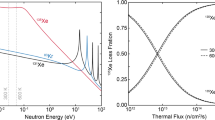Abstract
This study presents a method for destructive analysis of irradiated uranium (U) targets, with a focus on collection and measurement of long-lived (t 1/2 > ~10 years) and stable fission product isotopes of ruthenium and cesium. Long-lived and stable isotopes of these elements can provide information on reactor conditions (e.g. flux, irradiation time, cooling time) in old samples (>5–10 years) whose short-lived fission products have decayed away. The separation and analytical procedures were tested on archived U reactor targets at Los Alamos National Laboratory as part of an effort to evaluate reactor models at low-burnup.




Similar content being viewed by others
References
Hayes AC, Jungman G (2012) Determining reactor flux from xenon-136 and cesium-135 in spent fuel. Nucl Instrum Meth A 690:68–74. doi:10.1016/j.nima.2012.06.031
England TR, Rider BF (1994) Evaluation and compilation of fission product yields. Los Alamos National Laboratory, LA-UR-94-3106
Moody KJ (1995) Determination of plutonium metal origins. Lawrence Livermore National Lab., CA (United States), UCRL-ID-120253
Wyatt EI, Rickard RR (1961) The radiochemistry of ruthenium. National Academy of Sciences Nuclear Science Series
Rest J (1983) Evaluation of volatile and gaseous fission product behavior in water reactor fuel under normal and severe core accident conditions. Nucl Technol 61(1):33–48
Turnbull JA, Friskney CA, Findlay JR, Johnson FA, Walter AJ (1982) The diffusion coefficients of gaseous and volatile species during the irradiation of uranium dioxide. J Nucl Mater 107(2–3):168–184. doi:10.1016/0022-3115(82)90419-6
Metz V, González-Robles E, Müller N, Bohnert E, Herm M, Lagos M, Kienzler B, Serrano-Purroy D, Colle JY, Beneš O, Naisse F, Wiss T, Konings RJM, Wegen DH, Papaioannou D, Gretter R, Nasyrow R, Rondinella VV, Glatz J-P, Curtius H, Müskes HW, Like N, Bosbach D, Günther-Leopold I, Curti E, Froideval Zumbiehl A, Linder HP, Govers K, Verwerft M, Van Renterghem W, Lemmens K, Mennecart T, Cachoir C, Adriaensen L, Dobney A, Gysemans M, Vandenborre J, Traboulsi A, Blain G, Barbet J, Fattahi M, Sureda Pastor R, Slonszki E, Hózer Z, Roth O (2013) Characterisation of spent nuclear fuel samples and description of methodologies and tools to be applied in FIRST-Nuclides. Fast/Instant Release of Safety Relevant Radionuclides from Spent Nuclear Fuel FIRST-Nuclides. FIRST Nuclides—European Atomic Energy Community
Kudo T, Kida M, Nakamura T, Nagase F, Fuketa T (2007) Releases of cesium and poorly volatile elements from UO2 and MOX fuels under severe accident conditions. J Nucl Sci Technol 44(11):1421–1427. doi:10.1080/18811248.2007.9711389
Pontillon Y, Ducros G (2010) Behaviour of fission products under severe PWR accident conditions. The VERCORS experimental programme-Part 3: release of low-volatile fission products and actinides. Nucl Eng Des 240(7):1867–1881. doi:10.1016/j.nucengdes.2009.06.025
Finston HL, Kinsley M (1961) The radiochemistry of cesium. National Academy of Sciences Nuclear Science Series, Washington, DC
Meadows JWT, Matlack GM (1962) Radiochemical determination of ruthenium by solvent extraction and preparation of carrier-free ruthenium activity. Anal Chem 34(1):89–91. doi:10.1021/ac60181a025
Tandon L, Kuhn K, Martinez P, Banar J, Walker L, Hahn T, Beddingfield D, Porterfield D, Myers S, LaMont S, Schwartz D, Gallimore D, Garner S, Spencer K, Townsend L, Volz H, Gritzo R, McCabe R, Pereyra R, Peterson D, Scott M, Ruggiero C, Decker D, Wong A (2009) Establishing reactor operations from uranium targets used for the production of plutonium. J Radioanal Nucl Ch 282(2):573–579. doi:10.1007/s10967-009-0297-y
Gillson GR, Douglas DJ, Fulford JE, Halligan KW, Tanner SD (1988) Nonspectroscopic interelement interferences in inductively coupled plasma mass spectrometry. Anal Chem 60(14):1472–1474. doi:10.1021/ac00165a024
Horwitz EP, Dietz ML, Chiarizia R, Diamond H, Essling AM, Graczyk D (1992) Separation and preconcentration of uranium from acidic media by extraction chromatography. Anal Chim Acta 266(1):25–37. doi:10.1016/0003-2670(92)85276-C
Horwitz EP, Chiarizia R, Dietz ML (1992) A novel strontium-selective extraction chromatographic resin. Solvent Extr Ion Exc 10(2):313–336. doi:10.1080/07366299208918107
Marsh S, Ortiz MR, Abernathey R, Rein J (1974) Improved two-column ion exchange separation of plutonium, uranium, and neodymium in mixed uranium–plutonium fuels for burnup measurement. Los Alamos National Laboratory, LA-5568
Abernathey R, Matlack G, Rein J (1972) Sequential ion exchange separation and mass spectrometric determination of neodymium, uranium, and plutonium in mixed oxide fuels for burnup and isotopic distribution measurements. In: Proceedings of a symposia on analytical methods in the nuclear fuel cycle. IAEA, pp 513–521
Callis EL, Abernathey RM (1991) High-precision isotopic analyses of uranium and plutonium by total sample volatilization and signal integration. Int J Mass Spectrom 103(2–3):93–105. doi:10.1016/0168-1176(91)80081-W
Berglund M, Wieser Michael E (2011) Isotopic compositions of the elements 2009 (IUPAC Technical Report). Pure Appl Chem. doi:10.1351/PAC-REP-10-06-02
Acknowledgments
The authors would like to thank two anonymous reviewers and the editor Zsolt Revay for their comments and input. The authors would also like to thank K. Garduno and E. Lujan for their technical support. Los Alamos National Laboratory supported this work through LDRD funding. This publication is LA-UR-15-22675.
Author information
Authors and Affiliations
Corresponding author
Rights and permissions
About this article
Cite this article
Byerly, B., Tandon, L., Hayes-Sterbenz, A. et al. Determination of initial fuel state and number of reactor shutdowns in archived low-burnup uranium targets. J Radioanal Nucl Chem 307, 1871–1876 (2016). https://doi.org/10.1007/s10967-015-4538-y
Received:
Published:
Issue Date:
DOI: https://doi.org/10.1007/s10967-015-4538-y



